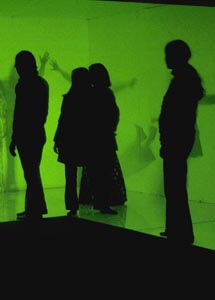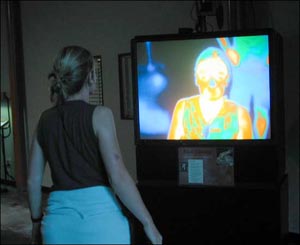
People and their shadows in the shadow box.
Bay Area Institute 2005
Using Exhibits to Teach Science Content in Teacher Professional Development Workshops
Part I, by Paul Doherty
This roundtable focuses on teacher workshops, in addition it will investigate many perspectives related to casual museum visitors, such as the diversity of the audience in terms of science background knowledge, the level of mediation, and the effect of learning in groups.
We would ike to address:
What we know or are learning
The implications of this for research AND for practice
and What we still need to learn to effect change.
At the Exploratorium, the Teacher Institute has been using exhibits
as part of our workshops for high school and middle school science
teachers for over 20 years.
We use the exhibits to provide participants with an opportunity to:
We'll use "Facilitated Exploration" to investigate the important science phenomena embodied in three exhibits.
The best way to learn how to do facilitated exploration is to actually do it at exhibits.
I've chosen three Exploratorium Exhibits to explore:
I will guide the participants through explorations at these exhibits, then we will go to a classroom to discuss what happened at the exhibits.
I chose these exhibits because they require three different levels of facilitation to extract the science behind the phenomena.

The Shadow Box preserves simple shadows on a wall, this exhibit needs minimal facilitation. However even with this simple exhibit a facilitator can provide suggestions for explorations that a group might not develop while at the exhibit. At a simple exhibit the facilitator shares observations and discoveries made by previous groups to inspire questions in the current group.

Colored Shadows Wall allows richer explorations of color addition and subtraction. The addition of red green and blue colored lights is complex enough that having a guide to suggest experiments will help participants in their explorations. At this exhibit the guide can bring in some of the stories of the discoveries about the primary colors of light, for example how the colors of the spectrum we know so well as ROYGBIV were actually chosen by Isaac Newton so that there would be 7 colors to match the 7 notes of the musical scale. The exhibit can also be used to subtract colors of light using a human body to block out some of the incident light, this results in the creation of the primary colors of pigment, magenta, cyan, and yellow.

Heat Camera shows an image of the world as seen by a far infrared camera. The facilitator at this exhibit needs to provide information to the participants so that they can begin to suggest experiments. The guide here can also suggest connections to the animal world, since pit vipers such as rattlesnakes "see" in the far infrared region of the spectrum revealed at this exhibit. A simple extra exploration can also be done at this exhibit by having participants line up by hand temperature so that the person with the hottest hands is at one end of the line while the person with coldest hands is at the other end. The hottest handed and coldest handed person then proceed down the line shaking hands with everyone else and then hold there hands up to the thermal camera.
Explorations at these exhibits are also available in writing on-line.
The Shadow Box, is written-up as a Snack in the book Square Wheels.
Colored Shadows Wall, is written up as an exploration on-line.
Heat Camera., is written up as an exploration on-line.
Hand Temperature, have people lineup by hand temperature.
This workshop is available online at Paul Doherty's site
Search for Paul Doherty on Google, I'm first on the list.
Or go to http://www.exo.net/~pauld
|
Scientific Explorations with Paul Doherty |
|
18 August 2005 |